Introduction
Hong Kong’s cha chaan teng, or “tea restaurants,” are a vibrant and integral part of the city’s culinary and cultural fabric. These eateries may be likened to American diners or “greasy spoons.” They offer a unique blend of Eastern and Western culinary traditions, reflecting Hong Kong’s rich history and diverse cultural influences. From their origins during the British colonial era to their evolution into beloved institutions frequented by people from all walks of life, cha chaan teng provide an authentic taste of Hong Kong’s dynamic food culture.
In this blog post, I’ll explore the fascinating origins and history of cha chaan teng. I delve into the cultural fusion that characterizes their menus. I also highlight some iconic dishes and beverages that define the cha chaan teng experience. Planning a visit to Hong Kong? Curious about its unique culinary landscape? This guide will offer valuable insights and recommendations to enhance your culinary journey. Let’s dive into the world of cha chaan teng and discover the flavours that make these tea restaurants unique.

Location of Hong Kong
Hong Kong is a vibrant metropolis on the southern coast of China, on the eastern side of the Pearl River Delta. It is known for its deep natural harbour, towering skyscrapers, and bustling urban life. Hong Kong consists of Hong Kong Island, the Kowloon Peninsula, the New Territories, and over 200 outlying islands. This strategic location has historically made it a major trading port and a cultural melting pot, contributing to its unique culinary and cultural landscape.
Origins and History of Cha Chaan Teng in Hong Kong
Hong Kong’s cha chaan teng (茶餐廳), or “tea restaurants,” are a fascinating culinary phenomenon. They embody many cultural influences that have shaped the region’s cuisine. To understand the origins of cha chaan teng, we must delve into Hong Kong’s history, particularly its period under British colonial rule from 1842 to 1997. This era saw a confluence of Eastern and Western culinary traditions, creating a unique fusion that defines Hong Kong’s food culture today.
Western cuisine permeated Hong Kong’s culinary landscape during the British colonial period. British officials and expatriates introduced dishes such as steaks, pies, and custards. These dishes were initially served in high-end restaurants catering primarily to Westerners.
However, as restaurants localized these dishes to suit the Cantonese palate, they became immensely popular among all social classes. The affordability and variety offered by cha chaan teng meant that construction workers, bankers, and even celebrities could enjoy a hearty meal in a casual, unpretentious setting. The popularity of this fusion cuisine led to the birth of the cha chaan teng in the post-World War II era, when Hong Kong was undergoing rapid industrialization and urbanization.
Fusion Cuisine
The cha chaan teng emerged as a popular, low-cost eatery that offered a unique blend of Cantonese and Western dishes. These establishments proffered extensive menus featuring an eclectic mix of traditional Chinese fare and Western-style comfort food, albeit with a distinctive local twist. For instance, diner cooks adapted British staples like scrambled eggs and toast using local ingredients such as spam and condensed milk. The result is iconic dishes like the fluffy scrambled egg sandwiches with spam, which became a hallmark of cha chaan teng cuisine.
Hong Kong’s cuisine also incorporates influences from other Asian culinary traditions. The diverse culinary practices from neighbouring regions such as Japan, Korea, and Southeast Asia have all contributed to the unique offerings of cha chaan teng. In summary, the rise of the cha chaan teng is a testament to Hong Kong’s dynamic and resilient culinary landscape. These tea restaurants have evolved from their colonial origins to become beloved institutions that reflect the city’s ability to blend and innovate across cultures. Today, they continue to serve as vibrant culinary hubs where tradition and modernity coexist, offering a unique taste of Hong Kong’s rich cultural heritage.
Cultural Fusion in Hong Kong’s Diner Cuisine
Hong Kong’s cha chaan teng cuisine vividly represents the city’s rich cultural history, embodying a unique blend of Cantonese, European, and Asian culinary traditions. This confluence of cultures is not just a historical artifact. It is a living, evolving aspect of Hong Kong’s identity, reflecting its dynamic and diverse population.
British Influence
The British colonial influence introduced a range of Western dishes and cooking methods to Hong Kong, which chefs adapted to local tastes. This fusion resulted in a distinct culinary style often called “soy sauce Western food.” For instance, cooks employed baking techniques brought by the British to create dishes like baked pork chop rice, a dish that marries Western baking with Chinese flavours. Similarly, Hong Kong-style Bolognese features a familiar pasta dish but uses ketchup and soy sauce, adding a sweet and savoury twist that appeals to local palates.
Portuguese Influence
The influence of Portuguese cuisine, mainly through Macau, is also evident in cha chaan teng offerings. The iconic egg tart, or dan ta (蛋挞), is a prime example. While often attributed to British custard tarts, the Chinese egg tart more closely resembles the Portuguese pastel de nata, which made its way to Hong Kong via Macau. This delicate pastry has become a staple in many tea restaurants with its flaky crust and creamy custard filling. The beloved dessert showcases the cross-cultural culinary exchanges that define Hong Kong cuisine.
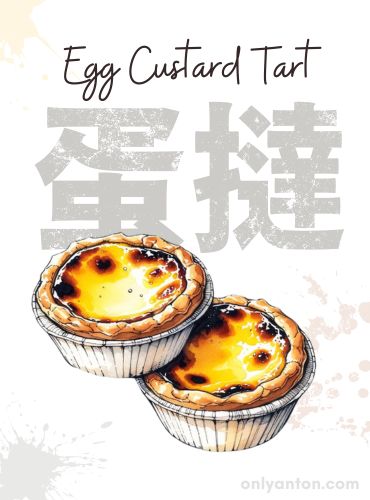
Asian Influences
Southeast Asian influences are also prominent in cha chaan teng menus. Dishes such as Hainanese chicken rice, originating from Hainan, China, but popularized in Singapore and Malaysia, reflect the broader Southeast Asian culinary impact. The use of ingredients like coconut milk and pandan leaves in desserts and drinks further illustrates this blend. For example, the drink hong dau bing (紅豆冰, “red bean ice”) combines sweetened red beans with evaporated milk and ice cream, echoing the flavours found in Southeast Asian desserts.
Japanese culinary techniques and ingredients have also influenced cha chaan teng cuisine. The love for Japanese flavours is evident in dishes like curry fish balls, where Japanese curry is adapted to suit local tastes. Additionally, the presentation and preparation methods of some cha chaan teng dishes, such as fluffy scrambled egg sandwiches, reflect the Japanese emphasis on texture and aesthetics.
Summary
The fusion of these diverse culinary traditions within cha chaan teng cuisine is a testament to Hong Kong’s ability to integrate and innovate. This blend reflects the historical influences of colonial rule and the continuous cultural exchanges with neighbouring regions. The result is a vibrant, eclectic cuisine that resonates with Hong Kong’s multicultural population. Cha chaan teng are not just places to eat but cultural institutions that capture the essence of the city’s heritage.
By celebrating this cultural fusion, the cha chaan teng offers a culinary journey that is both nostalgic and novel. These humble restaurants invite patrons to experience the rich, interconnected history of Hong Kong through its beloved comfort foods.
Must-Try Iconic Dishes at Cha Chaan Teng
The diverse menus found in cha chaan teng, with their unique fusion of East and West, offer a culinary experience that is both comforting and surprising. These tea restaurants are home to dishes that have become quintessentially Hong Kong. From hearty breakfasts to savoury snacks, each dish tells a story of cultural blending and innovation. Here, we explore some of the must-try dishes you can find at any cha chaan teng. Each represents a different facet of this rich culinary tradition.
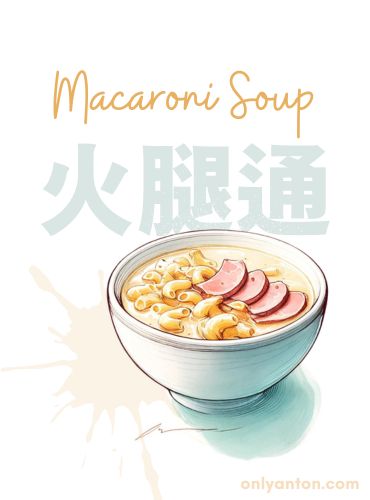
1. Macaroni Soup (火腿通, Fo Teoi Tung)
Description and Cultural Significance:
- This comforting dish features elbow macaroni cooked in a clear chicken broth and topped with ham. An alternative uses a creamy broth, typically made with Campbell’s condensed soup, such as cream of mushroom or cream of chicken. Fried slices of spam and a fried egg are layered on top. This dish perfectly encapsulates the practical, economical ethos of cha chaan teng cuisine.
- How to Enjoy It: Ideal for breakfast or a light lunch, enhance the flavours with a splash of Shaoxing wine and a sprinkle of white pepper. The combination of creamy broth and savoury spam makes it a hearty, satisfying meal.
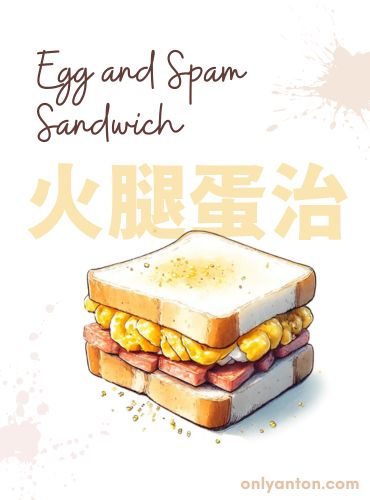
2. Scrambled Egg Sandwiches with Spam
Description and Preparation:
- This sandwich is a classic comfort food consisting of creamy scrambled eggs and slices of fried spam between two pieces of soft white bread. Sometimes, milk or cream enriches the eggs to provide extra fluffiness. But, more often, the secret to the smooth, silky texture is the addition of a cornstarch slurry to the eggs.
- Popularity and Variations: Widely loved for its simplicity and taste, variations include adding cheese or switching spam with ham, sausage, or corned beef. Some versions also use different types of bread, like brioche or whole grain, for a twist.
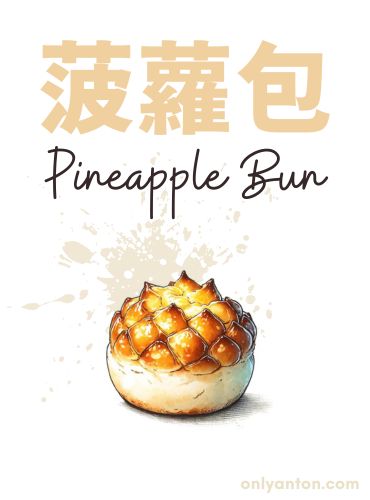
3. Pineapple Buns (菠蘿包, Bolo Bao)
Description and Ingredients:
- Despite its name, pineapple buns do not contain pineapple. The name comes from the crackled, sugary crust on top, which resembles the skin of a pineapple. The bun itself is soft and slightly sweet.
- History: Originating in Hong Kong, they are a bakery staple often enjoyed with a slab of cold butter (bolo yau).
- How to Enjoy: It is best eaten fresh from the oven, paired with Hong Kong-style milk tea. The combination of warm, soft bread and cool, creamy butter is a delightful contrast.
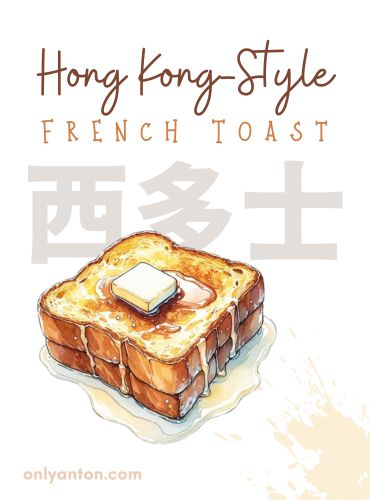
4. Hong Kong-Style French Toast (西多士), “Western Toast”)
Ingredients and Preparation:
- Like French toast, this dish involves dipping bread in an egg mixture and frying it until golden. Sweetened condensed milk or butter and sugar often accompany the dish.
- Comparison to French Toast: The Hong Kong version is typically thicker and sweeter, with variations that include fillings like peanut butter or jam. Sweetened condensed milk adds a unique, rich sweetness that sets it apart from other forms of toast.
5. Hong Kong-Style Bolognese
Typical Ingredients:
- This pasta dish includes ground meat (usually beef or pork), onions, tomatoes, and a generous amount of ketchup, which gives it a distinctive sweet and tangy flavour. Sometimes, the addition of soy sauce provides an extra umami kick.
- Comparison to British “Spag Bol”: While similar to the British version of Spaghetti Bolognese, the Hong Kong version has a unique twist. The use of ketchup instead of tomato sauce makes it a sweeter, more localized adaptation of the classic Italian dish.
6. Baked Pork Chop Rice (焗豬排飯, Gok Ju Pa Fan)
Ingredients and Preparation:
- Breaded pork chops are served over fried rice, topped with a rich tomato sauce, and baked. The sauce often includes ketchup for a unique flavour.
- Popularity and Variations: This beloved dish has variations, such as adding cheese or using different meats like chicken. Another variation combines marinated pork loin with sweet and savoury soy sauce. It is a quintessential comfort food, often enjoyed by families and individuals alike.
These iconic dishes represent the heart of cha chaan teng cuisine. They offer a delightful journey through Hong Kong’s unique culinary landscape. Each dish tells a story of cultural fusion, historical influences, and the innovation that characterizes Hong Kong’s food culture.
Unique Beverages and Drinks at Cha Chaan Teng
The cha chaan teng is not just known for its diverse and comforting food offerings. They also serve a variety of beverages that reflect Hong Kong’s rich cultural blend. These drinks range from strong teas to inventive concoctions, each with unique cultural significance and preparation methods. Here, we explore some must-try beverages that add to the charm and experience of dining at a cha chaan teng.
Silk Stocking Milk Tea
Preparation and Cultural Significance:
- This quintessential cha chaan teng beverage is made by brewing robust black tea and straining it through a sackcloth bag resembling silk stockings. A generous splash of canned evaporated milk is then added. The result is a creamy, slightly sweet tea that pairs perfectly with the savoury dishes typically served in these eateries.
- This drink embodies the British colonial influence on Hong Kong, where the practice of adding milk to tea was adopted and adapted to local tastes.
Variations and Serving Suggestions:
- Variations include the addition of sugar or honey for extra sweetness, and some versions might use condensed milk instead of evaporated milk for a richer flavour.
- Serving Suggestions: Serve hot or cold, depending on the weather and personal preference. Consumers often enjoy it as a breakfast drink or an afternoon pick-me-up.
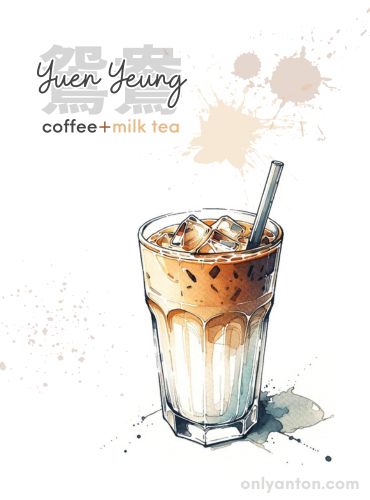
Yuen Yeung (鴛鴦)
Description and Cultural Significance:
- Yuen yeung (or yuan yuang in Mandarin) is a famous Hong Kong beverage that blends two parts milk tea with one part black coffee. The name “yuen yeung” refers to mandarin ducks, which are often seen in pairs, symbolizing the perfect harmony between the two distinct flavours of tea and coffee.
- This drink exemplifies the fusion of Eastern and Western influences, combining the intense flavours of Hong Kong-style milk tea with the rich, bold taste of coffee.
Preparation and Variations:
- To prepare yuen yeung, brew a strong black tea and mix it with evaporated milk and sugar. Brew a strong black coffee separately, then combine the two mixtures in the desired ratio.
- Variations: Some variations include adjusting the tea-to-coffee ratio to taste, using sweetened condensed milk instead of evaporated milk, or serving it iced for a refreshing alternative.
Other Notable Drinks
Hot Coca-Cola with Lemon and Ginger:
- Description and Preparation: This unusual but popular drink involves heating Coca-Cola with slices of lemon and ginger. The result is a soothing, warm beverage. Some believe it to have health benefits, particularly for soothing sore throats and alleviating cold symptoms.
- Cultural Significance: This drink showcases the innovative spirit of cha chaan teng, where familiar ingredients are used in unexpected ways to create comforting remedies.
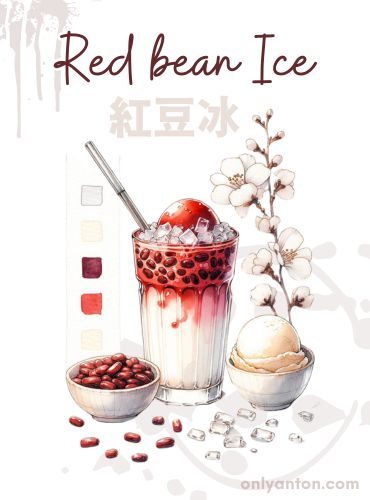
Red Bean Ice (紅豆冰, Hong Dau Bing):
- Description and Preparation: This sweet, refreshing drink is made with sweetened red beans, evaporated milk, vanilla ice cream, and crushed ice. It is a popular choice for hot summer days.
- Cultural Significance: This drink reflects the influence of Southeast Asian desserts and is a delightful example of the sweet treats available in cha chaan teng.
Other Suggestions:
- Salted Lemon 7-Up (鹹檸七): A fizzy, salty-sweet drink that adds salted lemon to 7-Up or Sprite. It’s a refreshing and unique beverage that helps beat the heat and quench thirst.
- Iced Lemon Tea (凍檸茶): A simple yet refreshing drink made by brewing strong black tea, sweetening it with sugar, and adding slices of lemon. Served over ice, it perfectly complements the rich flavours of cha chaan teng dishes.
These beverages’ distinctive flavours and cultural backgrounds are integral to the cha chaan teng experience. Whether it’s a comforting cup of milk tea or a refreshing red bean ice, each drink evokes Hong Kong’s rich culinary heritage and innovative spirit.
Notable Cha Chaan Teng to Visit in Hong Kong
Hong Kong is home to numerous cha chaan teng, each offering its unique take on the beloved fusion cuisine. These establishments are not just culinary landmarks. They are cultural icons that reflect the vibrant history and community spirit of Hong Kong. Here are some notable cha chaan teng that you should visit for an authentic experience.
Mido Café in Kowloon’s Yau Ma Tei District
History and Recommendations:
- Mido Café, established in 1950, is one of the oldest cha chaan teng in Hong Kong. It has retained its vintage charm with tiled floors, wooden booths, and neon signs, offering a nostalgic glimpse into the past.
- What to Try: Their egg sandwiches are a must-try, along with hearty noodle bowls and refreshing iced yuen yeung.
- Address: 63 Temple Street, Yau Ma Tei, Kowloon
Australia Dairy Company in Jordan District
Popular Dishes and Cultural Significance:
- Known for its silky-smooth scrambled eggs and fluffy egg sandwiches, Australia Dairy Company is a bustling hotspot attracting both locals and tourists. The restaurant’s name reflects the post-war era when Hong Kong imported large quantities of dairy products from Australia.
- Service Tips: The service here is notoriously fast-paced and brusque. Be prepared to order quickly, eat swiftly, and leave promptly to accommodate the next wave of eager diners.
- Address: 47 Parkes Street, Jordan, Kowloon
Lan Fong Yuen in Central District
Famous Drink and Recommendations:
- Lan Fong Yuen is celebrated for its iconic silk stocking milk tea, made using a unique family recipe that gives it a smooth and rich flavour. This establishment is a cornerstone of Hong Kong’s milk tea culture.
- What to Try: Besides their renowned milk tea, try their pork chop buns and instant noodles with ham and egg for a full cha chaan teng experience.
- Address: 2 Gage Street, Central, Hong Kong Island
Kam Wah Café in Mong Kok, Kowloon
Specialties and Ambiance:
- Kam Wah Café is famous for its delectable pineapple buns stuffed with a thick slab of butter and Hong Kong-style French toast. Despite often being crowded, the delicious offerings make the wait worthwhile.
- What to Try: Do not miss the pineapple buns and French toast, which are considered some of Hong Kong’s best.
- Address: 47 Bute Street, Prince Edward
For Kee Restaurant in Sheung Wan District
Signature Dish and Setting:
- For Kee Restaurant is renowned for its baked pork chop rice, a beloved dish that draws food lovers from all over. The combination of crispy pork chop, savoury tomato sauce, and fragrant rice makes it a standout choice.
- What to Try: For a satisfying meal, definitely order the baked pork chop rice, and consider trying their other offerings, like minced beef rice.
- Address: Shop J-K, 200 Hollywood Road, Sheung Wan
These iconic cha chaan teng each offer a window into Hong Kong’s culinary scene. Every dish and drink is a blend of history, culture, and flavour. Visiting these establishments is more than just a meal. It’s an experience that connects you with the heart and soul of Hong Kong.
The Complete Cha Chaan Teng Experience
Visiting a cha chaan teng in Hong Kong is more than just a culinary adventure. It’s an immersive cultural experience that reflects the city’s distinctive blend of efficiency, diversity, and community spirit.
Service Culture
Cha chaan teng are renowned for their brisk and no-nonsense service. The pace is fast, and the staff is typically curt. These characteristics embody the efficiency necessary to serve a high turnover of customers. This rapid service is a hallmark of these eateries, designed to get people in and out quickly. Don’t be surprised if your order is taken almost immediately after you sit down, and your food arrives within minutes. This efficiency ensures that the cha chaan teng can cater to many customers. The service may lack the personalized attention found in fine dining restaurants. Yet, it this very efficiency that has endeared cha chaan teng to many.
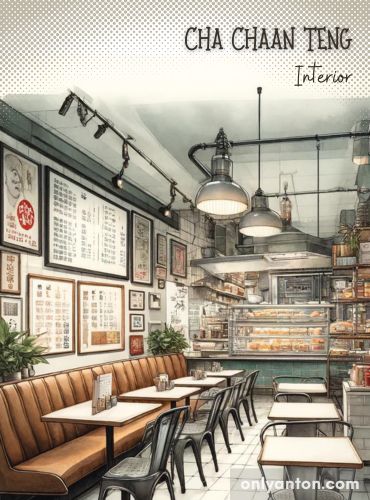
Atmosphere
The atmosphere in a cha chaan teng is vibrant and hectic. The inside of a cha chaan teng is often characterized by the clatter of dishes, the hum of conversation, and the occasional shout of an order being called out. The décor is typically spartan and functional, emphasizing maximum seating capacity.
Expect to find a mix of booth seating and communal tables. It is not uncommon to share a table with strangers during peak hours. The interiors often blend old and new. Vintage elements, like tiled floors and retro signage, coexist with more modern touches. This eclectic mix adds to the charm and authenticity of the cha chaan teng experience.
Cultural Significance
Cha chaan teng hold a special place in Hong Kong society. They serve as a melting pot where people come together from all walks of life. These eateries cater to a diverse clientele, from construction workers to bankers, students, and tourists. The wide range of affordable dishes ensures something for everyone, making cha chaan teng a truly democratic dining experience.
Beyond the food, cha chaan teng are cultural institutions that reflect Hong Kong’s history and evolution. They emerged in the post-World War II era as a response to the need for quick, affordable meals that blended Western and Chinese influences. They continue to be a testament to Hong Kong’s adaptability and cultural fusion. As everyday gathering places, the cha chaan teng plays a crucial role in fostering a sense of community and continuity in the fast-paced urban landscape of Hong Kong.
Conclusion
In conclusion, the cha chaan teng experience is quintessential to Hong Kong’s culinary and cultural landscape. With their roots in British colonial history, these establishments have evolved into unique dining spots that blend Eastern and Western influences. These tea restaurants do not merely offer delicious, comforting food. They offer a glimpse into the rich, multicultural history of Hong Kong.
The cultural fusion evident in their menus showcases a variety of dishes that combine Cantonese, European, and other Asian culinary traditions. From comforting classics like Fried Egg and Spam in Macaroni Soup and Pineapple Buns to unique beverages such as Yuen Yeung and Silk Stocking Milk Tea, these tea restaurants offer something for everyone.
The efficient service, bustling atmosphere, and significant cultural role these tea restaurants play make them an essential part of the city’s identity. Whether you’re a local or a visitor, dining at a cha chaan teng offers a genuine taste of Hong Kong’s vibrant life and history. If you ever find yourself in Hong Kong or another city with a significant Hong Kong diaspora, exploring a cha chaan teng is a must for any food enthusiast.
I invite you to share your own experiences and favourite cha chaan teng dishes in the comments. Have you visited any of these iconic establishments? What are your must-try dishes? Your stories and insights can help fellow travellers and food lovers discover the best of Hong Kong’s culinary scene. Happy eating!
Further Reading and Resources
For those interested in diving deeper into the world of cha chaan teng and Hong Kong’s culinary culture, here are some recommended books, articles, and websites that provide valuable insights and information:
Books
- Hong Kong Food City by Tony Tan (2019): This book explores Hong Kong’s diverse food culture, including traditional dishes and modern culinary trends. It features recipes and stories from local chefs and food enthusiasts. Look for it online, at a local library, or purchase it here.
- The Food of China by Deh-Ta Hsiung and Nina Simonds (2005): A comprehensive guide to Chinese cuisine. This book provides historical context and recipes for a wide range of Chinese dishes, including those influenced by Hong Kong’s unique culinary scene. Read it online, borrow it, or buy it online here.
Articles and Blog Posts
- “Hong Kong’s ‘greasy spoon’ cafes,” by Gary Jones, BBC (March 11, 2022): An article that explains how these restaurants serving Canto-European concoctions have become the heart of Hong Kong’s singular cultural identity. Read the article online here.
- “10 cha chaan tengs to visit in Hong Kong” by Sassy Hong Kong, Hong Kong Tourism Board: Hong Kong’s official tourism website offers a guide to tea restaurants, including recommendations and cultural insights. Visit the website here.
- “The 16 best cha chaan teng in Hong Kong” by Cherry Chan, Time Out Hong Kong (April 13, 2024): Find a curated list of the best cha chaan teng in Hong Kong here.
Websites
- Wikipedia: Cha Chaan Teng: A detailed Wikipedia entry that covers the history, cultural significance, and typical menu items of cha chaan teng. Find the entry here.
- OpenRice: Hong Kong Restaurant Guide: OpenRice is a popular food and restaurant guide in Hong Kong. It provides user reviews, ratings, and information on various cha chaan teng across the city. Visit the website here.





I think I would like the pineapple buns with butter. I’m not so keen on the condensed or evaporated milk concoctions nor spam and ketchup. However, if these dishes were eaten in Hong Kong, then that might make all the difference.